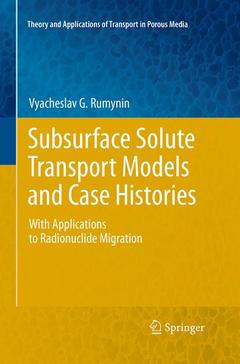Description
Subsurface Solute Transport Models and Case Histories, 2011
With Applications to Radionuclide Migration
Theory and Applications of Transport in Porous Media Series, Vol. 25
Author: Rumynin Vyacheslav G.
Language: English
Approximative price 158.24 €
In Print (Delivery period: 15 days).
Add to cartPublication date: 08-2016
Support: Print on demand
Publication date: 07-2011
815 p. · 15.5x23.5 cm · Hardback
Description
/li>Contents
/li>Comment
/li>
The book addresses the development of the basic knowledge of the subsurface solute transfer with a particular emphasis on field data collection and analysis coupled with modeling (analytical and numerical) tool application. The relevant theoretical developments are concerned mainly with the formulation and solution of deterministic mass-transport equations for a wide range of engineering issues in groundwater quality assessment and forecasting.
The book gives many computational examples and case studies drawn from the conducted field investigations. The analyzed problems are as follows:
- investigation and prediction of groundwater contamination by industrial contaminants and solutions (radionuclides, chloride and nitrate brine) with special focus on the effect of (a) aquifer heterogeneity, anisotropy, and dual porosity, (b) density contrast existing between industrial waste and groundwater, or in density-stratified artesian and coastal groundwater systems; (c) physicochemical interactions that play a major role in retarding (e.g. adsorption) or enhancing (e.g. interactions between dissolved species and mobile colloids) contaminant transport;
- prediction of the effects of pumping on groundwater quality at wellfields;
- groundwater dating using stable and radioactive isotopes for prediction and assessment of contamination potential;
- field and laboratory tests? design and analysis, and monitoring data interpretation;
- partitioning of surface and subsurface flows using isotope techniques.
One of the most essential topics addressed in the book is the migration and fate of radionuclides. Model development is motivated by field data analysis from a number of radioactively contaminated sites in the Russian Federation: near-surface radioactive waste disposal sites and deep-well radioactive waste injection sites. They play a unique role in the advancement of knowledge of the subsurface behavior and fate ofmany hazardous radionuclides and can be considered as field-scale laboratories.
Thus, the book, along with theoretical findings, contains field information, which will facilitate the understanding of subsurface solute transport and the development of a methodology for practical applications to groundwater hydrology.
Preface. 1. Advection and dispersion in saturated porous and fractured media.- 2. Flow and solute transport in unsaturated porous media.- 3. One-dimensional solute transport models for regional flow systems under areal recharge condition. Hydrodynamic models for isotope data interpretation.- 4. Profile (two-dimensional in vertical cross-section) models for solute transport in regional flow systems.- 5. Models for assessment of interlayer mass transfer by diffusion and vertical convection in stratified systems.- 6. Mass-transport models for fractured-porous reservoirs.- 7. Simplified reservoir models for flow and solute balance in coupled surface-water/ groundwater systems.- 8. Models for well tracer test analysis and interpretation.- 9. Models for prediction of effects of pumping on ground water quality at well-fields.- 10. Dynamic equilibrium between two liquids of different density.- 11. Formation of movable interface between two liquids of different density.- 12. Brine migration studies by means of numerical modeling.- 13. Modeling investigations of ground water contamination by industrial and environmental brines.- 14. Fundamentals of adsorption interactions and overview of experimental data.- 15. Radionuclide ground water contamination study and adsorption parameters estimation at "Radon" radioactive waste disposal site, Sosnovyi Bor, Leningrad region, Russia.- 16. Complex approach to study of Cambrian and Vendian clay formations as media for isolation of the radioactive waste (North-West region of Russia).- 17. Experimental and model investigations of adsorption-desorption processes (in application to radionuclide migration at sites of their deep injection disposal and near-surface storage).- 18. Colloid systems and adsorption equilibrium in them.- 19. Investigation of radionuclide colloidal transport at radioactive waste disposal site of the Siberian Chemical Combine.- 20. Migration models of adsorption type.- 21. Migration of the radionuclides onto colloids in multi-component solutions.- Conclusions.- References.- Index
These books may interest you

Groundwater in the Nile Delta 400.89 €



